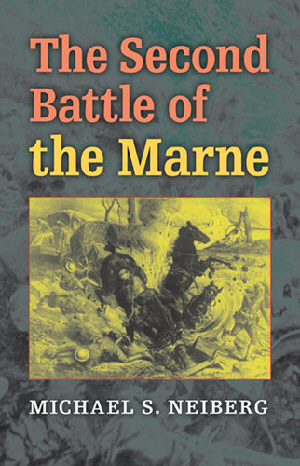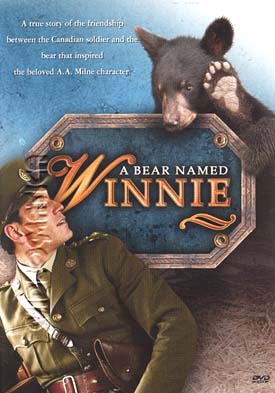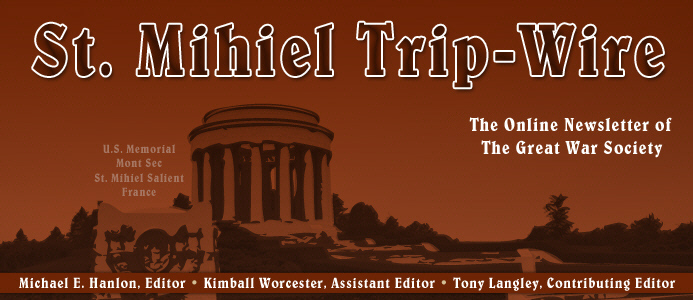

Christmas and New Year Issue
TRENCH REPORT: November 2009 was filled with evocative anniversaries. Naturally the commemorations around Armistice Day recalled the events and tragedy of 1914-1918 for all of us interested in the Great War. This year, however, memories of some other events which occurred in the eleventh month registered more strongly for me. I was traveling in Europe in November 1989 when the Berlin Wall started tumbling down. Everyone I met those days agreed that what we were witnessing was something we had never expected in our lifetimes. Communism--to our great surprise--was on its way to the "dustbin of history," the atomic terror we had feared for 40 years would soon vanish, the armies of the West could be demobilized in large part, and the world could prosper forevermore. It seemed so heady and hopeful 20 years ago. But also marked this November was the first anniversary of the terror attack at Mumbai, a template for using gps and cell phone technology to savage any peaceful city in the world. America's own recent tragedy at Fort Hood and a slew of other news stories about our efforts to confront the terrorist threat provided a reminder that we are not immune to such atrocities, and remain the most-prized target. November 2009 left me with a gnawing feeling that forces of disorder and irrationality are on the move worldwide and we are not responding forcefully enough, that our leaders, the elites, the highly educated, and the "good kind people" seem numb to the emerging threat. Hope I'm wrong. MH
This Month's Internet Feature
War in the Baltic
1915 Gulf of Riga Naval Battle
Fall of Riga 1917
Hutier Tactics at Riga, 1917
Operation Albion: The Attack on the Baltic Islands
The Baltic States, Brief Overview and Holdings at Hoover Institution
Soviet Recognition of Finland, December 1917
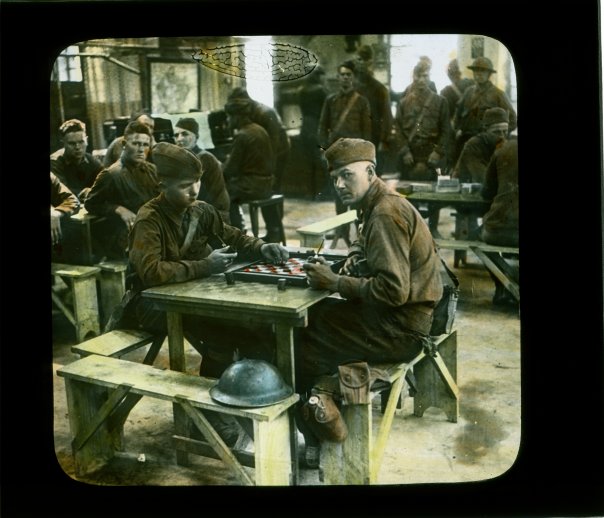
Checkers Game at a Salvation Army Hut
from the Salvation Army Collection

December 7th, of course, will be the anniversary of the attack on Pearl Harbor. Three of the battleships damaged or sunk on that day served in the European Theatre in World War I out of Ireland and were known as the Bantry Bay Squadron. They escorted convoys and guarded against German surface raiders. The squadron flagship, USS Utah--a target ship by 1941--was sunk on December 7 as was USS Oklahoma, which turned "turtle" due to torpedo and bomb damage. USS Nevada made a run for the open seas, but its captain chose to beach the ship rather than chance being sunk in the main channel. The Nevada was repaired and saw extensive service afterward, including as a bombardment ship at Normandy on D-Day.
|
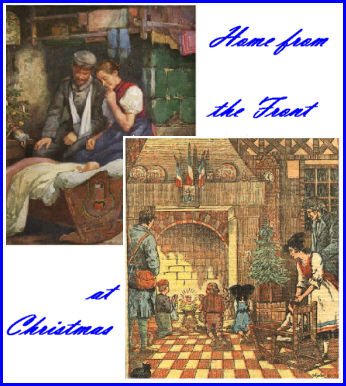
Similar German and French Christmas Cards from Contributing Editor Tony Langley's Collection
|
GREAT WAR 2010 EVENT CALENDAR
|
A Big Announcement
At the urging of new WFA-USA President Steve Suddaby (Congrats, Steve) the Trip-Wire will begin maintaining with our January 2010 issue a master schedule of all World War I-related events for the next two years. It will be in the form of a downloadable Word document and will include all U.S. and international WWI events, seminars and commemorations. This service is intended to both inform our readers and help the various organizations avoid scheduling conflicts. Please send us information on any events you know of. This system will work only if we have good information.
(email)
|
WFA-USA & TGWS Joint Annual Seminar
September 16-18, 2010
National World War I Museum,
Kansas City, MO
Mark your calendar. Check back for details in 2010.
|
Western Front Association
U.S. Branch Chapter Meetings
Check for Your Region
Regularly Updated (details)
|
Great War Society Monthly Chapter Meetings
Berkeley, San Francisco, and Palo Alto, CA
Regularly Updated (details)
|
Upcoming Events at the National World War I Museum
Kansas City, Missouri
Regularly Updated (details)
|
Send additions/corrections:
Email Response
|
Northern California WWI Event: On December 6, 2009, at the Mondavi Center at UC Davis (outside Sacramento) vocal group Cantus will present All Is Calm, a selection of songs, poetry, letters, and journal excerpts relating to the extraordinary World War I incident known as "the Christmas Truce," when soldiers who had heard each other singing carols put down their weapons to celebrate Christmas together. (event details)
101 Wonders of Woodrow Wilson House: Hidden Treasures from the Presidential Collection will be on display to January 17, 2010, at the Woodrow Wilson House, 2340 S Street, N.W. Washington, D.C. 20008
(info)
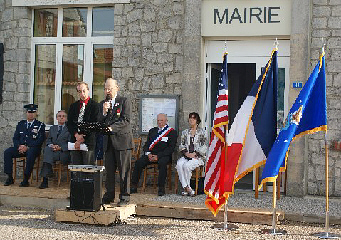
On October 7, the Medal of Honor deeds of 50th Aero Squadron Members Edwin Bleckley and Harold Goettler were commemorated at Remicourt in the Argonne. Reader and League of WWI Aviation Historians member Jerry Hester (with the mic at the podium) organized the event.(link)
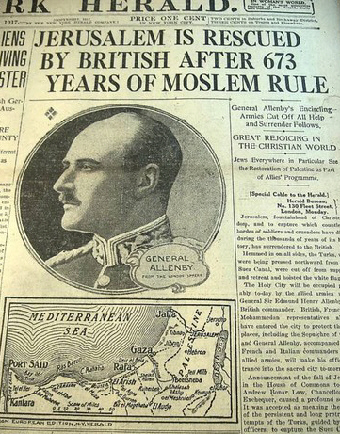
An Interesting Headline from
December 1917

We are at rest five miles behind the front. Yesterday we were relieved, and now our bellies are full of beef and haricot beans.
Opening passage, All Quiet on the Western Front
|
|
Page Two
|
|
|
| Some Wartime Christmas Memories |
AEF, Christmas 1917
From the Capt. Alban Butler Collection,
First Division Foundation Museum, (Thanks to Shane Keil)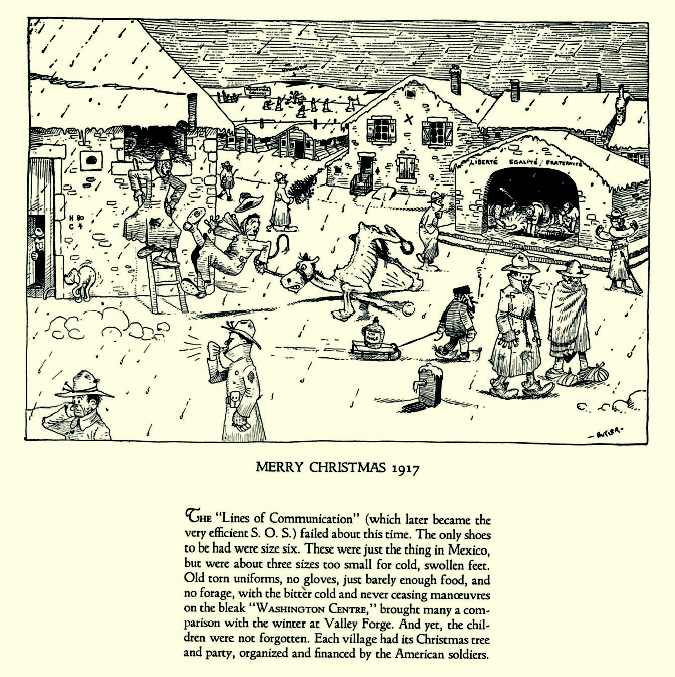
From the recently discovered diary of Sapper Jack Martin,
a signaller with the Royal Engineers in Flanders
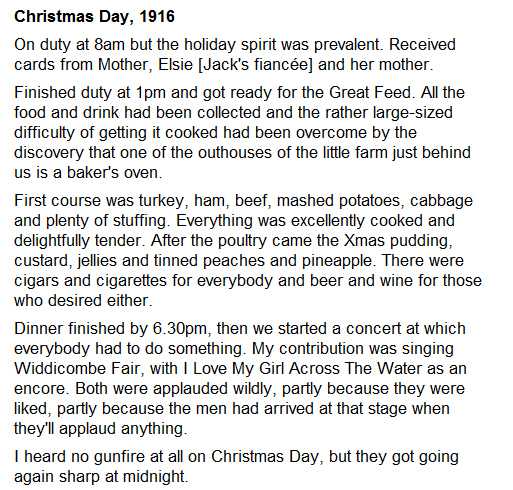
Photos from the Front
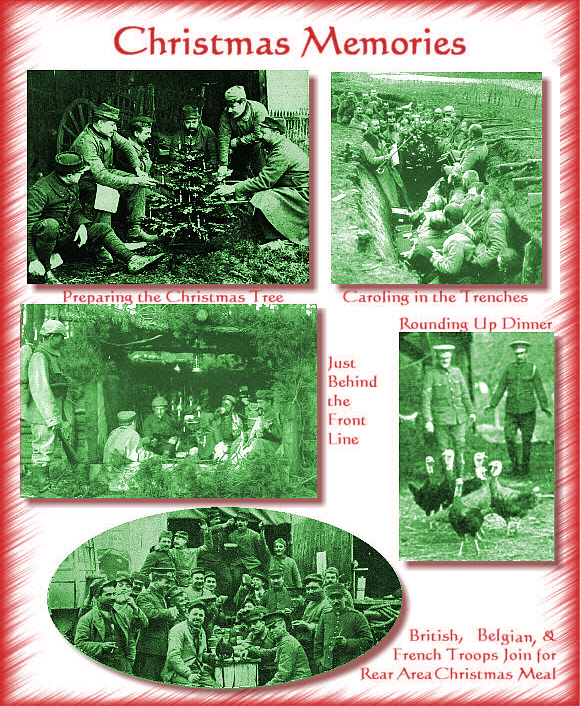
|
|
 |
|
|

German Minenwerfer Firing Position, Western Front, 1917
|
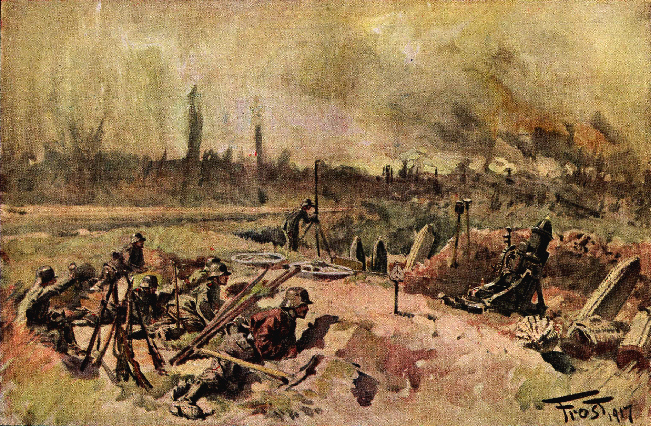
By Martin Frost, from the German publication Der Krieg in Wort und Bild 6
|
Click Here to Visit the Website of Our Contributing Editor Tony Langley
War in a Different Light
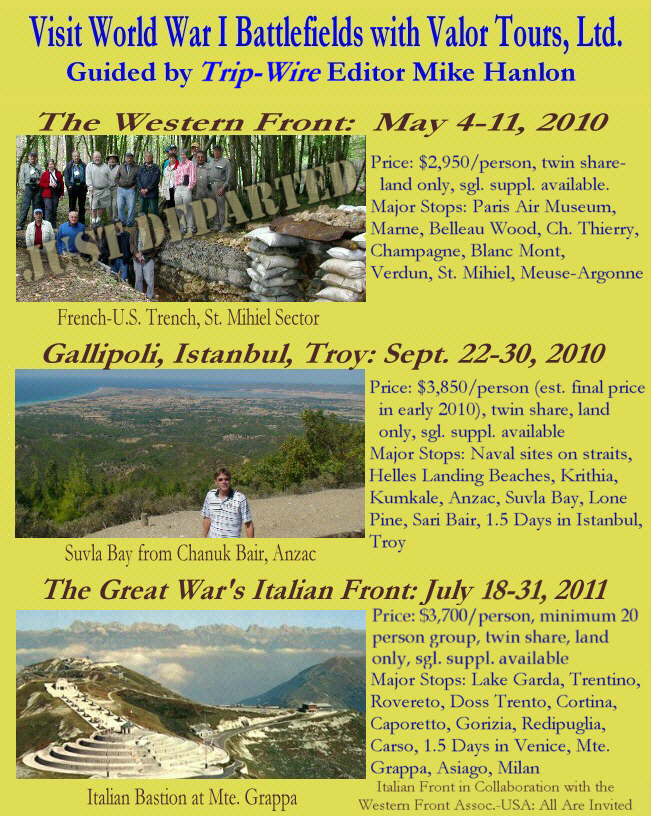
(Click on image or email Mike Hanlon at greatwar@earthlink.net to request a brochure for Western Front tour or more details on the other trips)
|
|
Subscribe to Our Online Magazine
|
|

|
|
|
Page Three
|
|
|
The Great War Society's Annual
Armistice-Remembrance-Veterans Day Event |
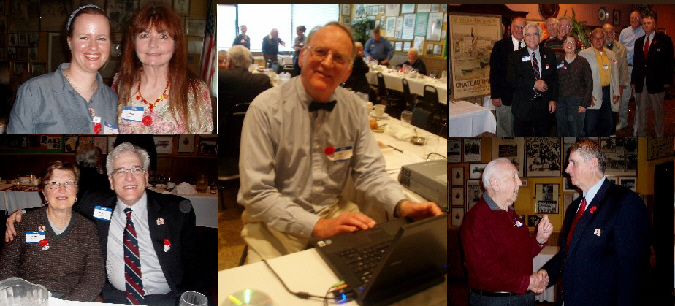
On Saturday, November 14, 62 members of the three Northern California chapters of The Great War Society met at Francesco's Restaurant in Oakland to remember the veterans and fallen of the war and to experience the fellowship for which the organization is well known. The theme was "Honoring the Doughboy Generation," and the program included: presentations on the AEF's origins, heritage, and key facts; a documentary film on the cemeteries and monuments of the American Battle Monuments Commission; and a travelogue featuring the National World War I Museum in Kansas City. Great food and refreshments plus an "Everyone a Winner" Raffle added to the enjoyment.
In the photos above, clockwise from the top left, we have pals Rachel Schweissinger of Sacramento and TGWS Marketing Director Diane Rooney, Treasurer Bob Denison who made the A/V-heavy program hum along, a group picture of the volunteers and main presenters for the day, member John Symons congratulating Master of Ceremonies [and Trip-Wire Editor] Mike Hanlon on the successful event, and a contented-looking President Dana Lombardy and his lovely wife, Anne.
|
|
World War I Headlines
in the
21st Century
|
|
 |
Michael Neiberg's The Second Battle of the Marne
Reviewed by Elizabeth Greenhalgh, University of New South Wales at the Australian Defence Force Academy
|
[Editor's Comment: Michael Neiberg's book on the Second Battle of the Marne has recently received the Tomlinson Prize as the outstanding World War I volume published in 2008.]
Michael Neiberg has begun a serious effort to take into account a much wider view of the First World War. His recent (2005) brief global history of that conflict gave an overview of the major questions that politicians and the military on all fronts had to face in conducting this modern, industrial war. In this his latest work Neiberg has turned from the big picture to a single Western Front action, responding to an invitation to write a study of what he calls "the most important twentieth-century battle about which there was no important monograph". The invitation was extended by Spencer C. Tucker as editor of the series "Twentieth-Century Battles" in which the work under review is published. The other works in this series that deal with the First World War are Timothy C. Dowling on the 1916 Eastern Front Brusilov Offensive (2008) and a further two on naval battles.
On seeing the words "Battle of the Marne" most readers think of the September 1914 battle that put an end to the German invasion of Belgium and France. The second battle of that name took place in July and August 1918 and marked the turning point as the last of the five German offensives on the Western Front between March and July were halted and the Allied counteroffensives began, resulting in the Armistice less than four months later. The two Marne battles were completely different in planning and execution and reveal the enormous changes that had taken place over four years of war in both men and materiel. However, despite the crucial place of the Second Battle of the Marne in the Allied victory, it has received little attention from historians.
This neglect is the result of the often asserted proposition that France has lost every war in which it has been involved since Napoleon, hence could not have taken part in the 1918 battles. Since the country's political and military leaders sat at the victors' table in the Galerie des Glaces, Versailles to watch the signing of the peace treaty, such an assertion can only be a gross misrepresentation of France's effort in the First World War. The war cost France dearly, as the title of Robert A. Doughty's recent study of French strategy and operations between 1914 and 1918 reveals, but that fact only increases rather than diminishes France's role during that conflict.
The failure to appreciate France's effort in the final year of the war derives from several causes. First of all, within France, it is only fairly recently that historians and the general reading public have begun to study the first of the 20th century's destructive wars fought on French soil, possibly because military history itself became more acceptable once the trauma of 1940 had begun to be expressed in print. Moreover, the French official history of the First World War, Les Armées Françaises dans la Grande Guerre, itself devotes much less space to Second Marne than to the 1914 battle, the latter receiving a whole volume to itself. . .Second, English-speaking historians have downplayed France's role, not because of any anti-French sentiment but because of a concentration on "national" history. Hence, in the U.S. for example, historians have concentrated on the (very limited) [Ed. comment: Both Professor Neiberg and the reviewer understate the American contribution in this battle. See further comment below.] American experience of the fighting. This has led to such unfortunate works as John Mosier's Myth of the Great War, which aims to prove that the decadent Europeans required an infusion of American blood in order to gain victory; hence it was the Americans who won the war.
It is unlikely that more scholarly works, such as Robert B. Bruce's account of Franco-American relations, which emphasises the role that France played in arming, training, and equipping the American Expeditionary Forces, will overcome the popular appeal of Mosier's polemic. The anti-French tone of works such as Mosier's has been reinforced by the World War II experiences of Vichy France and the Roosevelt–de Gaulle antipathy, as well as by more recent conflicts in the Middle East. In Britain, a similar concentration on national history has led to neglect of France's contribution. This neglect began with the assertion of the British commander-in-chief, Sir Douglas Haig, that it was the British Army that won the war, and it continues to this day. While the necessity to write national history is vital, it is time to take a broader perspective on the 1914-1918 conflict especially since English is taking over the world of communications and fewer and fewer students learn a foreign language. Part of the reason for the neglect of the French story is an inability amongst American and British (and Commonwealth) historians to read the voluminous French sources, both published and archival.
The author's implicit aim is, therefore, to redress the neglect of this 1918 battle which marked the start of the march to victory, and Neiberg is right to offer the reader an analysis of this strangely neglected but important First World War battle. He joins Robert Doughty in putting the French Army back into the 1918 fighting. For too long the Anglocentric concept of "The Hundred Days" that led to victory-–counting from the Franco-British Battle of Amiens on 8 August, thus ignoring Second Marne–-has dominated the historiography. It must be acknowledged, however, that the phrase "The 122 Days" does not have the same Napoleonic ring to it.
Three introductory chapters set the scene briefly, with an account of the first three years of the war, followed by the evolution of the French, British, and German armies during those years. Next, two chapters relate the German preparations and their prosecution of Operation MARNESCHUTZ-REIMS, the last of the five German offensives in the West. The German intention was twofold: to consolidate their position along the Marne by capturing Reims, thereby improving communications into the sector; and to draw French reserves to the area, hence, away from the British lines further north, so that the German high command could launch a decisive attack on the British (Operation HAGEN). Finally, four chapters deal with the turnaround from defence against the German onslaught to the phases of the counterattack and the German retreat northwards. In his conclusion Neiberg "honors" General Ferdinand Foch who as supreme Allied commander had masterminded the international response on the Marne. He contrasts Foch's command style (vindicated by his being raised to the dignity of marshal) with the lack of operational skill in the German high command, and he reiterates the conclusions of Doughty and Michel Goya among others that the French Army was not the "worn-out, tired" army that it is so often portrayed. Tired it certainly was, but it was not worn out and played the dominant role on this battle. Of the 59 divisions engaged in the double defensive–offensive action, 46 were French [Ed. Comment: The reviewer fails to note here that the nine American Divisions committed were 2 to 2.5 times larger than the comparable units of the Allies. Also, they did much of the heavy lifting in the assaults.]
Although France supplied the greatest number of troops to Second Marne, Neiberg is even-handed in giving due weight to the British corps and to the American divisions that fought in the battle. Indeed, this was the most "international" of the Western Front battles, especially since an Italian corps was also involved in the fighting.
Neiberg gives a comprehensible exposition of the action, based largely on published sources, with the help of clear standardised maps. He provides a good description of the geography of the battlefield. He uses a vivid image of the Marne pocket that the Germans had created when they penetrated southwards across the river as a paper bag whose neck the Allies attempted to close from both east and west, so as to cut off supplies to the enemy troops inside the bag, thus forcing them to surrender or be killed. This image ties together neatly the different stages of the battle. Furthermore, the account is enlivened by an effective selection of eyewitness accounts.
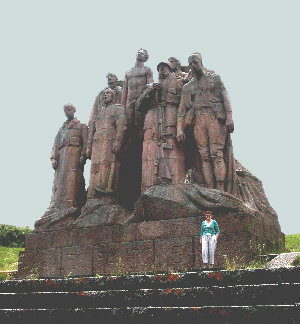
Les Fantomes
France's Monument to the 2nd Marne |
Nevertheless, there are some lacunae. The Italians supplied a whole army corps to the fighting in France, in compensation for the French and British troops who had gone to Italy after the disaster at Caporetto in October 1917 and who remained there until war's end. Italian labourers and auxiliary troops also provided support in France. Yet the Italians are missing from Neiberg's account. The two divisions of II Italian Corps suffered so badly in the German attack as they defended the front astride the River Ardre that they had to be relieved. Neiberg describes very well the difficulties of terrain in the Ardre valley and relates the hard fighting that the British XXII Corps, who relieved the Italians, had to endure. Yet the author comments in a footnote that most Allied officers had "a generally low impression" of the Italians and that the latter "were quickly relieved of their place in the line and transferred away." This is to do an injustice to their stalwart defence as part of Fifth Army, and to the corps' 14,874 casualties during their time in France (9334 of them between 15 and 24 July). When Neiberg has a reputation for taking a wider than usual perspective on the war, and when he is restoring the French Army to its rightful place in the story of 1918, it seems strange that the Italian role should be so dismissed. Certainly, President Raymond Poincaré noted that the corps commander, General Albricci, a former military attaché in Vienna, was intelligent. "Tous les généraux français font son éloge," Poincaré noted.
The account of the battle would have benefited from a greater emphasis on the role played by the intelligence services. Although Neiberg does point out that the Allies knew that the German attack was coming, the French intelligence services were playing a pivotal role by July 1918. At French headquarters the head of the 2e Bureau, which dealt with intelligence matters, was so confident that the German attack could not be launched before 15 July that he went on leave in the days beforehand. His confidence derived from the studies he had made of the railways resources that the enemy could use in the salient and of how much capacity those resources provided. His office was also supplying to Foch daily reports of the numbers, positions, and readiness for battle of the German divisions in France. Since Foch's confidence in the state of the enemy forces was a key factor in his request that Sir Douglas Haig, the British commander-in-chief, move British divisions to the Marne sector and also in his countermanding of Pétain's suspension of the preparations for the counteroffensive, the role of the intelligence service in the success should perhaps have received greater attention.
The most significant development in the way the Allies fought in 1918 involved what has become known as the "bataille interarmes," the all-arms battle. No longer did the outcome depend on the infantry and on the artillery alone, but aviation and tanks also played significant roles in dominating the battlefield. Once again, in this reader's opinion, too little space is given to this aspect of the Second Battle of the Marne. As General Mangin's Tenth Army infantry debouched from the forest of Villers-Cotterêts on the western edge of the battlefield, they were preceded by hundreds of Renault FT tanks-–like a swarm of angry wasps–-and they were over-flown by a cloud of aircraft from the newly formed Division Aérienne. Usually the Battle of Mondidier that began on 8 August further north alongside the British (the Battle of Amiens) is cited as the all-arms battle par excellence, yet more tanks and more aircraft were deployed on the Marne. There are plenty of histories of tanks and of aviation, and an evaluation of the use of these two arms would have given an even more rounded picture of the battle, bringing it yet further out of the neglect that it has suffered.
There are other smaller problems, some geographic. On page 11, the rivers Marne, Ourcq, Vesle, and Aisne are described as running towards the east, whereas they all flow westwards and all end eventually in the Seine before reaching the Atlantic. Marfaux on the maps becomes (wrongly) Marfeux in the text. Errors have crept in to the introductory account: Foch's Ninth Army did not attack into the marshes of St-Gond during the 1914 Battle of the Marne, nor could the British slow advance into the gap between the two German armies during the same battle be described as a "charge." It is misleading to state that Foch could not give orders to the French Army under its commander-in-chief General Philippe Pétain, because on 26 June 1918 Pétain's right of appeal against Foch's orders was revoked. Therefore, at the time of Second Marne, Pétain was indeed obliged to obey Foch's orders. Finally, to avoid angry letters from any Scottish readers, it is not heather but the thistle (le chardon) that is Scotland's emblem.
More important than these minor points is the question of Paris and the significance of the national capital in the war. Neiberg claims that "[l]arge elements of the French government had fled Paris" for Bordeaux as a result of the German shelling of Paris and the earlier German offensive on the Chemin des Dames in May 1918. But, although arrangements were made to shift gold and other securities, the government remained in Paris, the Chambers continued to sit, and Poincaré stated that he would not leave Paris as he had done in 1914. Certainly there was no chance that Premier Georges Clemenceau would leave voluntarily. Since Neiberg cites Clemenceau's defiant words: "I will fight in front of Paris. I will fight in Paris. I will fight behind Paris," it is puzzling, therefore, why he believes that "large" sections of the government had decamped. Indeed Paris plays too large a role altogether. The capture of the capital was not the German intention in 1914. The imperative was to defeat the French Army speedily so as to be able to turn to the east and to defeat the Russian Army. A decisive victory in the field was the goal, not the inevitable delays involved in capturing Paris. Nor was Paris the goal in 1918. As David Zabecki has shown in his recent study of the German 1918 offensives (and Neiberg acknowledges his help), the German aim was to defeat the British. Operation MARNESCHUTZ was therefore only to be a preliminary to Operation HAGEN against the British in the north, due to begin a few days after the Marne action had drawn away French reserves. The successful Allied defence and counterattack on the Marne prevented HAGEN from taking place. Hence Neiberg's insistence on Paris as a long-term goal is odd, especially as he admits that "there is no evidence that Paris was an immediate, or even a medium-range, goal of the Germans in July".
Neiberg himself states that he hopes not to have written the "final word," but he has made an excellent start on repairing the neglect of the Second Battle of the Marne, thereby restoring the French Army to the 1918 battlefield. That army had learned much since 1914 about how to fight a modern battle, and Neiberg has shed important light on the obscurity surrounding that learning experience.
Michael S. Neiberg, The Second Battle of the Marne. Bloomington and Indianapolis: Indiana University Press, 2008. xii + 217 pp. Maps, notes, bibliography, and index. $27.95 U.S. (cl). ISBN 978-0-253-35146-3.
"The following/preceding review originally appeared in H-France Review, vol. 9 (July 2009), No. 96: (link)."
|
|
 |
From the Archives -- A Christmas Gift Suggestion
A Bear Named Winnie
Reviewed by Andrew Melomet
|
Directed by John Kent Harrison and originally produced for the Canadian Broadcast Corporation, A Bear Named Winnie tells the story of the World War I Canadian regimental mascot (2nd Canadian Infantry Brigade) that inspired the A.A. Milne character Winnie the Pooh. The story begins in 1914 with a young veterinarian, Lt., Harry Colebourn (Michael Fassbender) of The Fort Garry Horse leaving Winnipeg en route to the army camp in Quebec. At a rest stop in White River, Ontario, he buys an orphaned bear cub for $20 (the equivalent of about $350.00 in today's Canadian currency) and names her Winnie after his home base of Winnipeg. After training in Valcartier, Quebec, the Canadian Expeditionary Force sails for England. Unwilling to part with Winnie, Harry smuggles her aboard ship and into the camp at Salisbury Plain. When the regiment is ordered to France, Harry realizes he must part with Winnie and arranges for her to be temporarily housed in the London Zoo. He plans to take Winnie back to Canada after the war. But, while she's been at the zoo she's become a star attraction due to her gentle friendliness. When Harry returns, he's faced with either bringing Winnie back to Canada or letting her stay at the zoo. Once he realizes what a hit she is with the children he donates her to the London Zoo permanently. Harry Colebourn would return to Winnipeg alone.
Winnie was extremely tame. Parents could even place their children on her back for rides. A favorite activity was to give Winnie a drink of condensed milk mixed with corn syrup. Winnie lived at the zoo until 1934. In the last two years of her life she had cataracts and arthritis and suffered a stroke that partly paralyzed her. She was euthanized on May 12, 1934.
A.A. Milne and his son Christopher Robin were frequent visitors to the London Zoo. Christopher Robin loved Winnie and renamed Edward Bear, his stuffed teddy bear, Winnie the Pooh. (Pooh also happened to be the name for the family swan.) The first story with Winnie appeared in the London Evening News in December 1925, and over the years, A.A. Milne wrote a series of stories based on the adventures of his son's stuffed animals. In 1966, Walt Disney released the first animated short starring Winnie, Winnie the Pooh and the Honey Tree.
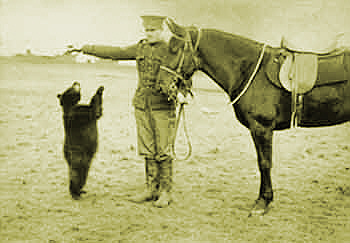
Early Photo of the Friends
This is a delightful family film with only a brief battlefield sequence. It's well acted, both by the humans and the bears. You feel there's a true warmth and friendship between Winnie (played by two cubs and a full-grown bear) and Harry. Gil Bellows plays Col. John Barret, the stern Chief Veterinary Officer who is won over by Winnie's warmth. David Suchet is General Hallholland, the often drunk commanding officer of the Canadian Expeditionary Force. Stephen Fry plays Mr. Protheroe, the cranky keeper at the London Zoo who likes animals more than children and reluctantly accepts the young Winnie as a temporary guest.
Currently, in Winnipeg's Assiniboine Park there are two tributes to Winnie: a bronze statue of Captain Colebourn and Winnie, and an original oil portrait of Winnie-the-Pooh by the illustrator Ernest H. Shepard.

Friendship Remembered: Captain Colebourn and Winnie
Statue at Assiniboine Park and 1996 Canadian Stamp
A Bear Named Winnie makes a perfect heartwarming Great War-themed gift for the holiday season. I reviewed the Canadian DVD in 2005 but here in the U.S. A Bear Named Winnie is currently available on DVD from Monarch Video. The Canadian DVD includes both English and French language versions, brief Behind-the-Scenes segments on the bears used in the movie and the training methods, plus interviews. Of particular note is the 1987 CBC interview with Harry Colebourn's son. Since I haven't seen the Monarch Video release I can't vouch for the inclusion of these extra features. Note that the Monarch Video DVD cover features a picture of a Grizzly Bear. Winnie was a Black Bear.
Click here to download the 2004-2008 Index for the Nickelodeon
with Updates on Availability of Films and Videos in the U.S.
Check the Archives for 2009's reviews.
|
|





















